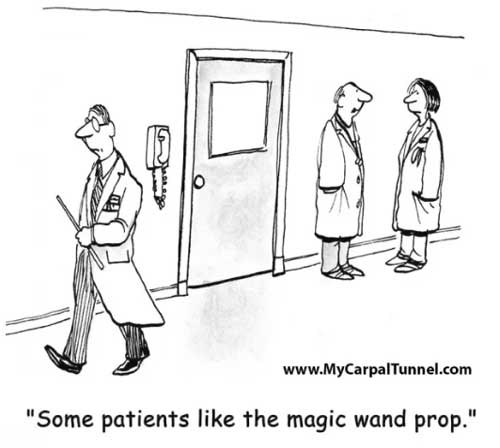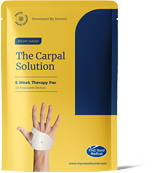What is the Best Treatment for Carpal Tunnel Pain?

By Doctor Michelle Robin, DC. Wellness Expert, Founder of Your Wellness Connection, Naturopath.

What is the Best Treatment for Carpal Tunnel Pain?

By Doctor Michelle Robin, DC. Wellness Expert, Founder of Your Wellness Connection, Naturopath.


There are many ideas for treating carpal tunnel syndrome. These methods range from invasive carpal tunnel surgery with all the risk and complications to rigid splints that are applied at home. Splints only immobilize your hand and provide no proactive therapy or treatment.
The question looms: What is the best Treatment for Carpal Tunnel Syndrome and why is one treatment modality better than another?
From the Doctors’ perspective at First Hand Medical, there are four major components that make one treatment modality better than another.
For instance, the Risk associated with a particular treatment is an important factor to be considered.
Another factor that should weigh heavily is the success rate of a given treatment.
Also, it is important to consider the costs of the treatment. The obvious cost is the money outlay required for the treatment, but a more subtle cost is the downtime away from work and/or lost opportunity that may result.
An often overlooked issue One should always consider is: how long do the treatment’s benefits last. Often, with Carpal Tunnel Surgery, people get rushed into the surgical procedure thinking that Surgery is a permanent fix. The reality settles in later when the person’s symptoms return a few months or years down the line and they face a repeat surgical procedure. CTS comes back even after Carpal Tunnel Surgery for over 85% of people. This can be a hard reality because, while first surgeries have a 50 – 60% success rate, second surgical procedures only have a 35 -40% success rate due to the formation of scar tissue during the first surgery. Surgeons are taught in medical school not to perform a third surgery for Carpal Tunnel Treatment.
So, with Carpal Tunnel surgery symptoms return within a time frame of 3 months to 8 years. Most people do not want to undergo the risks and expose themselves to the potential complications and downtime for a surgical procedure that is not a permanent fix.

To effectively rank and evaluate a Carpal Tunnel Treatment correctly, it is important to gain the patients’ perspective from patients who have used the treatment and done independent reviews of how they liked it and how will it work for them.
The patient’s perspective is essential in evaluating which treatment is best.
A good example of how and why Surgeons and medical clinicians do not always provide a great source for evaluating a treatment is the following:
There is a discrepancy in success rates reported by surgeons for carpal tunnel surgery as compared to Patient Surveys on Satisfaction with Carpal Tunnel Surgical Procedures.
Surgeons report success rates of over 90% with the procedure for Carpal Tunnel Release Surgery. While patients only report a 50 to 60% success rate for the same surgical procedure. So, most people would ask: “Why the big gap between a surgeon’s perspective and the patient’s perspective”
The following explanation should help you understand the complexity of such a seemingly simple question: “What is the success rate of Carpal Tunnel Surgery?”
Surgeons look at it from a completely different perspective than the patient. The Surgeon’s view is:
If there is any improvement in any of the symptoms of Carpal Tunnel after the surgical procedure, the Surgeon counts the surgery as a success.
Patients have a completely different point of view. If the Patient does not get completely better after the procedure (No Symptoms), the Patient is not happy to pay the money, experience the pain, have the downtime or expose herself to the risk only to get relief of some of the symptoms of carpal tunnel syndrome.
The Patient expects complete recovery and a permanent fix. This is why there is such a wide discrepancy in the success rates a Surgeon might report and the success rate reported in patient surveys.
There are other factors that cause patients discomfort and make them wonder:
“Why did the surgeon made surgery seem so simple and easy before surgery when Surgery turned out to be a major hassle!”

“Being without one’s hand for weeks can really be a hardship, not to mention the hand pain during rehabilitation that is intense. Why did I suffer through all of this -Only to get rid of some of the symptoms?
From a Surgeons perspective the Carpal Tunnel Release Surgical Procedure is one of the simplest and easy procedures he will perform. Carpal Tunnel Surgery only takes less than a half an hour to perform the procedure, it is usually performed in an out-patient clinic away from the rigors of the hospital and there is little chance for negligence law suits because the procedure simply calls for the surgeon to severe the Transverse Carpal Ligament and then sew the muscle and skin back together so it will heal.
Patients on the other hand find out that the surgeon has to cut through many layers of fascia and muscle tissue to get to the Transverse Carpal Ligament if they are doing an open procedure. These are the biggest and strongest muscles of the hand. The Ligament and the muscle tissue all heal back together with scar tissue. The scar tissue can complicate recovery dramatically. Sometimes scar tissue makes Carpal Tunnel Syndrome Symptoms worse post-surgery, because the scar tissue will create permanent pressure on the nerve that was not there before.
We all take our hands for granted until we lose use of them for a couple of weeks. Life is hard without having both hands available for the essential tasks of life.
Another factor creating mismatched expectations is Surgeons and clinicians deal with the risk and potential complications of surgical procedures every day. It becomes routine for them. It is necessary for a surgeon to develop a mentality where they minimize the concern over surgical risks and potential complications from surgery to not be overly concerned and focus on the downside of surgery. Instead they focus on the positive outcome and how they can best achieve it.
When a complication arises, such as an infection, Surgeons know routine methods for dealing with the complications and tend as a group to minimize the drama and concern with such complications.
However, from the patient’s perspective, the risks can be a very big deal. Infections are extremely painful and can result in long term damage to tissue and even be life threatening. Stroke is another general risk associated with any Surgical Procedure that patients consider a big deal. The list goes on.
Patient’s usually ask: “Why would I take the risks with surgery, if there is a non-invasive Carpal Tunnel Treatment that has no risk and that has a high success rate based on patient surveys?”
That is the right question.
So, what is the Best Treatment for Carpal Tunnel Pain Relief?

Neurologists generally agree that the best first line treatment for Carpal Tunnel Syndrome is a treatment developed by Doctors that is non-invasive, works for over 97%, is clinically documented, FDA Registered, has no risks, requires no downtime, and cost less than $100. The results last for 2 – 7 years after completing a 6 Week Treatment Regimen. It is a night time stretching treatment that puts your worst symptoms of Carpal Tunnel in remission within 2 – 3 weeks and puts all symptoms in complete remission within 6 weeks.
You can get better during sleep without exposing yourself to the Risk, complications and downtime of carpal tunnel surgery.
The Treatment is known as the Carpal Solution Treatment and it is generally recognized as the best first line treatment for Carpal Tunnel Syndrome. You worst Carpal Tunnel Pain can be put in remission within 2 – 3 weeks and complete remission of this dreadful syndrome within 6 Weeks.
Here is how The Carpal Solution measures up on the criteria listed above:
Factors Determining The Best Treatment
Applied to The Carpal Solution
1-Risks – No Risks
2-Success Rate – 97% Clinically Documented
3-Costs – Under $100 per hand
4-How Long Do the Treatment’s Benefits Last? – After the 6 Week Treatment Symptoms go into remission for 2 – 7 years for most patients.
 Created by renowned Harvard health care professionals.
Created by renowned Harvard health care professionals. 



